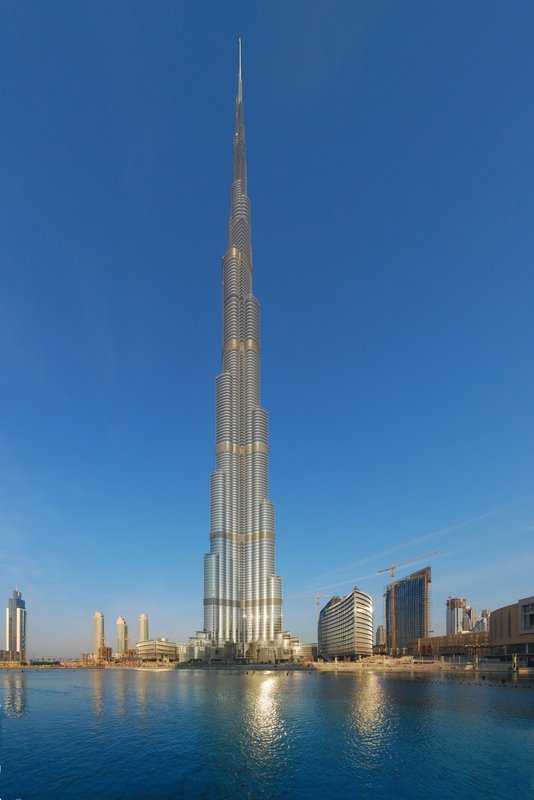 Copyright © Michael Richmond.
This work is licensed under a Creative Commons License.
Copyright © Michael Richmond.
This work is licensed under a Creative Commons License.
Elevators, now and in the future
In the good old days, the tallest skyscrapers
were less than H = 400 m tall.
For example, this building's top floor is about
383 meters above the ground:

But in the modern age, the tallest buildings are
much larger.
The Burj Khalifa, for example, is about H = 800 m
tall.

What happens to elevators as they must pull cars up
taller and taller buildings?
Can we continue to make them out the same materials?
Let's find out.
Some information you might find useful:
density of steel: 7800 kg/m^3
Young's modulus of steel: 200 x 109 N/m^2
ultimate strength of steel: 800 x 106 N/m^2
Our elevator has a car of mass M = 2000 kg.
It is supported by a steel cable with radius
r = 0.0308 m and circular cross section.
- what is the mass of the steel cable for
an "old" building of H = 400 m?
- what is the tension at the top of the cable,
if the car is motionless at ground level?
- how does that tension compare to the ultimate
(breaking) strength of the cable?
- the car must ride to the top of the lift
in t = 30 sec total.
What is a reasonable acceleration?
- under this acceleration, what is the
maximum tension in the cable when
the car is just rising from the ground floor?
- consider a spot in the cable half-way from
top to bottom, when the car is at the ground floor.
How much does the cable stretch at this point?
Now, let's look at more modern buildings, with
H = 800 m.
- what is the mass of the steel cable for
a "new" building of H = 800 m?
- the car must ride to the top of the lift
in t = 30 sec total.
What is a reasonable acceleration now?
- under this acceleration, what is the
maximum tension in the cable when
the car is just rising from the ground floor?
How does this compare to the ultimate strength?
- consider a spot in the cable half-way from
top to bottom, when the car is at the ground floor.
How much does the cable stretch at this point?
What about the energy required to move the car
and the cable up from the ground to the top?
- how much energy does it take to raise the car
to the top of the "new" building?
- how much energy does it take to raise the cable
to the top of the "new" building?
(This isn't so obvious ....)
- what fraction of the total energy required
is due to raising the cable?
Some companies have developed new materials
which are as strong as steel, but much lighter.
For example,
the
Kone UltraRope
is said to have the same strength as steel
at only 1/7 the mass.
Can you see why these new materials
are of great interest to engineers?
 Copyright © Michael Richmond.
This work is licensed under a Creative Commons License.
Copyright © Michael Richmond.
This work is licensed under a Creative Commons License.

 Copyright © Michael Richmond.
This work is licensed under a Creative Commons License.
Copyright © Michael Richmond.
This work is licensed under a Creative Commons License.

 Copyright © Michael Richmond.
This work is licensed under a Creative Commons License.
Copyright © Michael Richmond.
This work is licensed under a Creative Commons License.